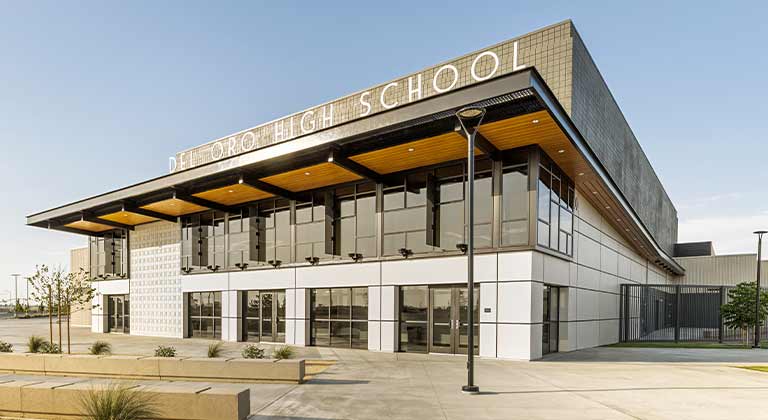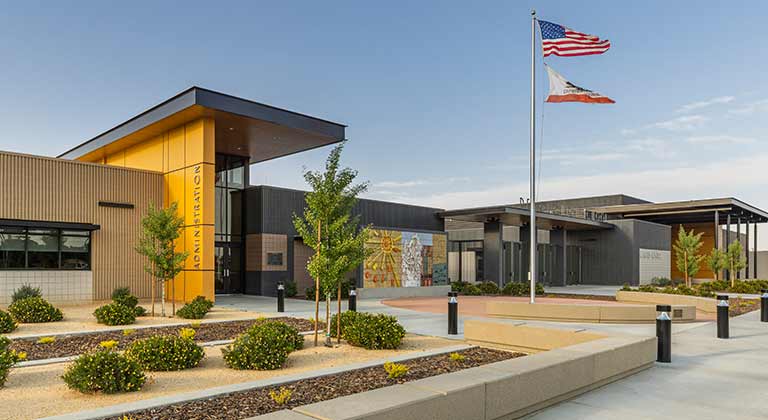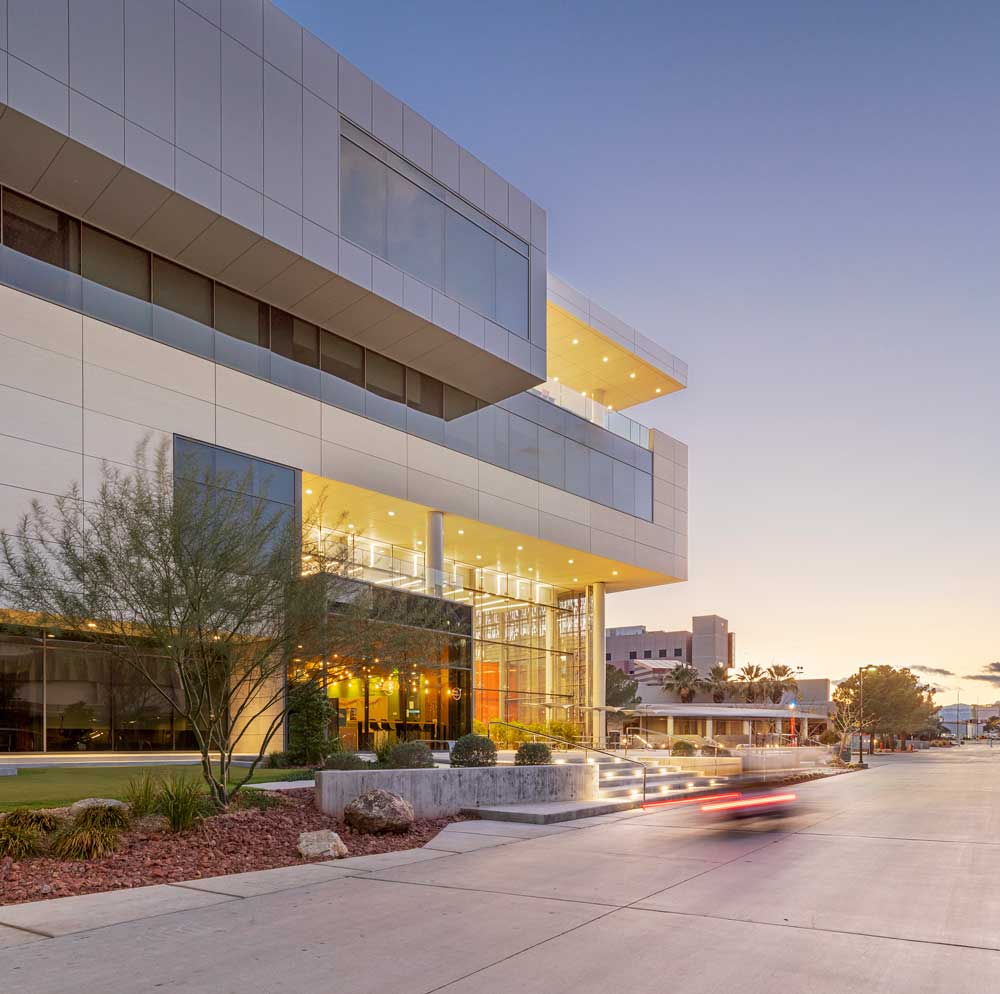Cladding is the process of covering one material with another in construction. Cladding with different types of metal wall panels offers several benefits for the exterior façade of a building, including protection, insulation, noise reduction, privacy, security, fire prevention, and aesthetics.
Metal wall panels and cladding systems play a significant role as components of the building envelope in the design and performance of buildings. Glass and glazing have an impact on the effectiveness of all types of metal wall panels, as these materials can alter the performance of the paneling.

Types of Metal Wall Panels
To ensure optimal results, selecting the right type of metal panel for a specific project is essential.
Metal wall panels are versatile and can create unique designs and serve specific functions. Some of the popular options and their benefits are compared below.
Metal Composite Material (MCM) Panels
MCM panels are typically made by combining two metal aluminum sheets with a central polyethylene core. Alternately, they can be made from steel, zinc, copper, stainless steel, or titanium, as well.
MCM panels provide many benefits, including:
-
- Fire-retardant properties
- Weather resistance
- Water resistance
- Durability
- A smooth and flat appearance
- Fewer problems with oil canning
Single-Skin Metal Wall Panel
Single-skin metal wall panels are inexpensive and commonly used for their unlimited design options. These panels provide:
-
- A sleek look
- Thermal movement, when clips are added
- Heat and moisture protection, when insulation is included
Using exposed fasteners with these types of metal wall panels can save money and time. They can be layered easily, save time in the installation process, and panels can be installed either horizontally or vertically.
Plate Panels
These systems offer design freedom, functionality, and high performance. Architects choose these metal wall panels when seeking a wider array of design options in the façade’s sub-layers, depths, curves, perforations, and tapers. For these reasons, plate panels often enhance a building’s aesthetic.
Insulated Metal Panels (IMPs)
IMPs can be delivered fully finished and sealed, ready to install, saving time and money in labor costs, as well as these additional benefits:
-
- They’re an effective solution for reducing both energy costs and temperature fluctuations.
- They can be installed quickly.
- They enhance energy efficiency, and meet most green energy codes.
- They can be used for both interior and exterior finishing surfaces.
Lap-Seam Metal Panels
These are installed by joining thin metal sheets and overlapping the edges, often with gutter or sealant tape, to ensure a tight seal. Panels are typically fabricated into 4-foot x 20-foot strips, with sheets measuring less than 0.05 inches thick.
Benefits of Using Metal Wall Panels and Cladding Systems
Metal cladding provides multiple functions and comes in a variety of colors and styles. Used as a protective material against the elements, it’s often the preferred system for industrial and commercial building exteriors. Due to its malleability, it can be connected in a variety of ways, meeting complex design and aesthetic requirements.
Metal cladding is a popular choice for builders worldwide for its many benefits:
Water and Fire Resistance
Metal wall panels are waterproof because they repel moisture. They protect building exteriors from mold, mildew, fungi, and algae and provide a high degree of fire resistance.
Low Maintenance and Durability
Due to their sturdy and long-lasting nature, metal cladding guards against abrasion and corrosion. Many types of metal wall panels are also low maintenance and require little cleaning.
Exceptional Insulation
Metal wall panels typically provide outstanding insulation properties. The insulation of cladding panels can effectively prevent air leakage from both the exterior and interior, enhancing a building’s energy efficiency and lowering energy expenses.
Lightweight
The lightweight design of the metal wall panels ensures that they do not add to the dead load of a building.
Easy to Install
Installing metal wall panels is a streamlined process that facilitates timely and efficient project completion, minimizing potential setbacks or delays.
Exceptional Moldability
These panels are highly flexible and customizable, making them suitable for various uses. They can be shaped into different forms and come in multiple textures and colors, adding to their visual appeal.
Types of Metal Cladding Systems
Metal panels can be connected and attached to a building in various ways due to their versatility. Each system type offers benefits in terms of construction complexity and aesthetic finish.
Some of the most common metal cladding systems are:
Standing Seam
Standing seam cladding is widely used. Its strong folded connections between panels and hidden fixing details create a smooth and modern exterior, making it a popular option for different types of buildings.
Snaplock
Snaplock cladding systems are much simpler to install than standing seam systems. They both have similar ribbed profiles, but this type requires no specialized equipment to close the seams. True to their name, snaplock panels snap together quickly and easily.
Interlocking
Interlocking metal cladding panels provide a sleek and visually impressive look, with joints that stand out. These panels are fabricated in different widths, and can be installed in horizontal, vertical, or diagonal patterns.
Flatlock and Shingle
The flatlock panels interlock seamlessly to form a smooth and flexible thin exterior. Additionally, the system can be set up in reverse to produce more visually apparent lines, known as “reversed flatlock.” For a unique twist on the flatlock design, the panels can be folded into interlocking tile shapes to create a shingled metal façade.
Cassette
The open-jointed cassette system can easily cover large areas, with huge panels fabricated in lengths of up to 13 feet. Providing a modern and sleek appearance, the system is created by bending cassettes attached to an aluminum framework with invisible clips.
Sustainable and Durable Materials for Metal Cladding Systems
Some metals are sustainable because they can be recycled and can withstand harsh weather conditions. Consider these following metal types in terms of the sustainability benefits they each offer when used in cladding systems:
Steel: Steel plates are strong, fire-resistant, and corrosion-resistant but are not sustainable, due to their energy-intensive production, and composition, which includes non-recycled materials.
Aluminum: These types of metal wall panels are lightweight, durable, and contain anticorrosive properties. They are more expensive than steel plates, but are easily recyclable. One negative feature is that aluminum plates tend to dent easily.
Copper: Copper is visually appealing and corrosion-resistant – a plus for sustainability — but is costly and requires a lot of maintenance.
Zinc: Using zinc is a good option because it appears visually similar to copper, but is much more affordable. It also offers anticorrosive properties and requires minimal maintenance, but it’s not as strong as other metals, and may require protective coatings.
Corrugated panels: These panels are affordable, lightweight, easy to install, and inexpensive. However, they are not as strong as other options.
Design Considerations for Metal Cladding Systems
Achieving a balance between design elements, materials, and performance is key to ensuring a successful metal cladding system. When designing your system, consider the following:
Material: Choose a metal that meets the desired aesthetic and requirements for performance and durability. It’s important to carefully consider each material’s benefits in making your selection. Some advantages to consider are corrosion resistance, thermal expansion, and compatibility with other materials used in the building envelope.
Weather Resistance: Metal cladding must protect against rain, wind, and UV radiation. A sound system prevents water infiltration and includes suitable joint detailing, connection systems, flashing and weeping systems, and transitions.
Thermal Performance: When designing for metal cladding, it’s important to consider its thermal properties, like conductivity and insulation, to improve energy efficiency and prevent condensation issues.
Fire Safety: Evaluate the fire performance of the metal cladding system, including its flammability, flame spread, and fire resistance, while complying with local building codes.
Aesthetic Considerations: Consider design features like color, texture, surface finishes, panel sizes, and panel joint patterns to achieve the desired visual effect.
Maintenance and Durability: Choose metal cladding that requires minimal maintenance and has long-lasting durability, such as resistance to corrosion, fading, and staining, and ease of cleaning and repair.
Sustainability: Choose eco-friendly metal cladding products made with recycled materials or sustainable practices that reduce your structure’s carbon footprint.
The Role of Glass and Glazing in Metal Cladding and Wall Panel Design
Cladding and glazing provide various benefits, including regulating the internal environment, reducing noise, shielding from external elements, and enhancing appearance. Cladding also protects the building’s exterior, maintains sanitation, and prevents the spread of fire. Features such as termite resistance, waterproofing, eco-friendliness, and a wide choice of colors and designs are some reasons for its popularity.
Glass is ideal for high rises because it’s transparent, sustainable, provides natural light, visibility to outside, and thermal protection. It’s strong yet lightweight, and can be customized for solar control and thermal insulation. Here are some popular glazing systems and their respective benefits.
Curtain Wall Glazing System
Curtain wall glazing is comprised mostly of glass. It’s used in high-rise buildings, with exterior walls suspended from concrete floor slabs and precast concrete walls. Correctly installed, it can withstand wind and earthquake loads, prevent air leakage, and reduce heat loss.
Double-glazed curtain walls can insulate efficiently, reduce energy consumption, and offer aesthetic appeal. Their most significant benefits include the opportunities to:
- enhance insulation
- use shading to prevent increased cooling loads and high wind loads
- provide ventilation through controlled openings in the external skin.
Some negatives include its cost and, in some cases, the need to mitigate glare issues.
The Importance of Proper Installation and Design for Optimal Performance
To optimize the efficiency of each type of system, it’s critical to install them professionally and according to manufacturers’ instructions. Not doing so can result in aesthetic issues, costly construction setbacks, and structural and/or thermal performance and other failures.
A Fully Functional Metal Cladding Wall System
Metal cladding systems can create the world’s most advanced and aesthetically pleasing buildings while providing many benefits for buildings. They create controlled internal environments, prevent sound transmission, protect buildings from external conditions, and provide comfort through effective thermal insulation. Cladding provides access to ventilation and prevents the spread of fire. Its properties can enhance waterproofing, environmental friendliness, sun protection, safety, and security. Most visibly, it provides the design elements that give every building its unique aesthetic appeal.
Choosing the right materials for your cladding system will determine whether a building will successfully achieve optimal benefits. Your choice of glazing company is paramount, as the success of any cladding system will depend on its correct and professional installation.


